Sometimes, a collection of brands falls under the overarching umbrella of a larger firm or company.
A large parent company uses various brand names to introduce products and services to fulfill the requirements of different market segments.
This relationship between brands is called a brand portfolio, with the parent brand holding a portfolio of sub-brands.
Picture a family tree with the primary brand at the head of the family. In that case, all the branches and offshoots are different brands, often targeting different audiences and market segments.
These brands can be sub-brands or individual brands in their own right.
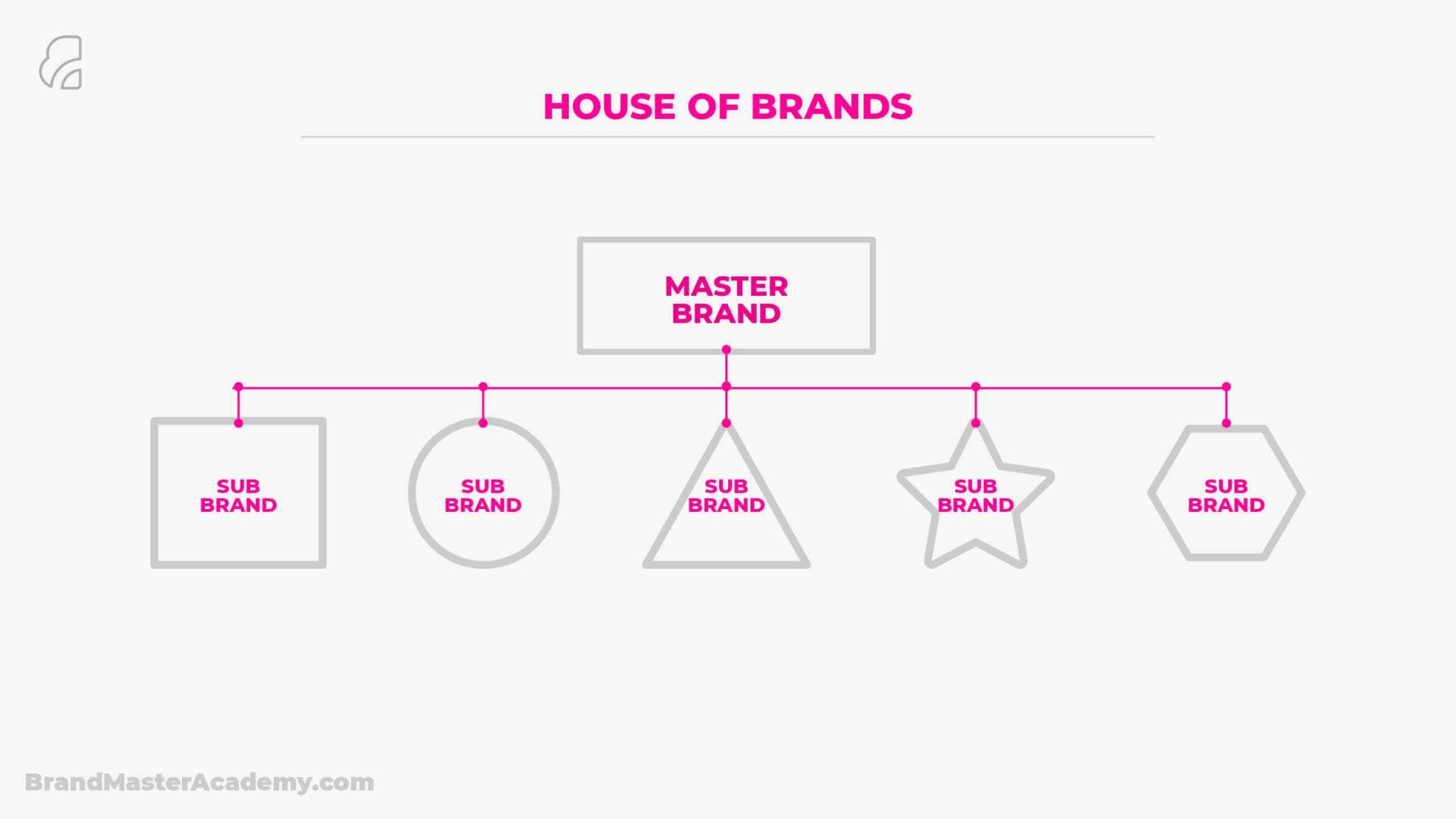
Each brand is its own entity and can be operated differently from its parent company but is ultimately part of the parent brand’s portfolio strategy.
Depending on the relationship, there are different levels of alignment.
For example, Emporio Armani, Giorgio Armani, and Armani Exchange are all brand extensions within the broader Armani brand portfolio.
In contrast, Always, Head & Shoulders, and Pampers are individual brands in their own right within Procter & Gamble’s brand portfolio.
Let’s unpack the idea of brand portfolios, explore their advantages, and examine some well-known examples.
What is a Brand Portfolio?

A brand portfolio is a group of brands that are part of a broader “brand umbrella” or “house of brands” created by a business, corporation, or conglomerate.
The Coca-cola company is one of the best-known brand portfolios. Of course, the Coca-cola company’s most famous brand is its flagship beverage, Coke.
However, besides Coke, the Coca-cola company has over 200 brands within its worldwide brand portfolio, including brands offering softdrinks, alcoholic beverages, juices and teas, and dairy products.
Household brand names like Sprite, Fanta, and Costa Coffee are all within the Coca-cola brand family.

Companies typically build, extend, and maintain brand portfolios to establish themselves in different market segments and appeal to a broader range of potential customers.
Brand portfolios exist in virtually every industry.
That’s because there’s always a case for a brand portfolio strategy to allow a company to grow and increase its market share.
To show this, let’s engage in a hypothetical case study.
When To Use A Brand Porfolio

Although some of the best examples of a brand porfolio are giant brands, this approach and strategy is not limited to brands with hundreds of millions of dollars in revenue.
Small brands with multiple products may decide to brand each product to create a clear and transparent offering to its customers, which can provide the structure for growth.
Established brands that want to enter a new market or increase it’s market share may decide to create a new sub-brand, thus creating an umbrella branding structure and the first in its brand portfolio.
More often than not, the decision to use a brand portfolio comes down to diversification, expansion, and increasing market share.
PRO Brand Strategy BluePrint
Build Brands Like A Pro Brand Strategist

Brand Portfolio Case Study

Let’s imagine a company that sells high-end luxury clothing.
This flagship brand has gained a reputation as a status symbol, meaning it can sell products at a high price point to an exclusive clientele.
However, the company’s market research shows that a significant portion of its target market has shifting priorities.
Customer preferences are erring toward more cost-effective clothing options.
This scenario presents a dilemma for the flagship brand.
The flagship brand’s identity is built upon offering luxury items, and the audience expects to pay premium prices for a high-quality, luxurious product.

Offering new products at more affordable prices risks causing damage to the company’s brand by turning off the most loyal customers.
In this scenario, the flagship brand may choose to create an entirely new brand or acquire a brand to satisfy the demand of the growing market segment.
The new brand would concentrate on offering more affordable clothing with a branding strategy to match. This strategy helps the flagship brand avoid engaging in conflicting mixed messaging that could be harmful if it was to bring more affordable products to market.
The new brand would be part of the flagship brand’s brand portfolio.
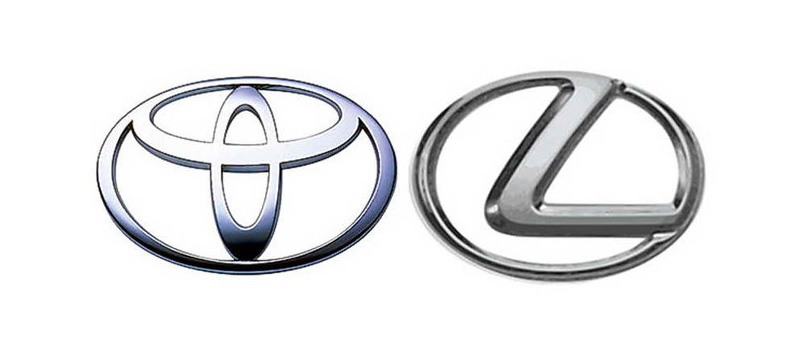
In 1989, Toyota decided to enter the luxury car market, but they knew they would face a challenge with a reputation as an affordable car brand.
Rather than confusing the market, they created the luxury car brand Lexus as a sub-brand within the Toyota brand portfolio.
Within a brand portfolio, brands tend to fall into one of several predetermined roles.
Each brand category has a part to play in the overarching brand portfolio strategy.
Often, businesses will build and sustain brands with different roles to complement one another to maintain a competitive advantage and increase market share within a category.
Explore Brand Strategy
Programs & Tools
What Are Brand Portfolio Roles?
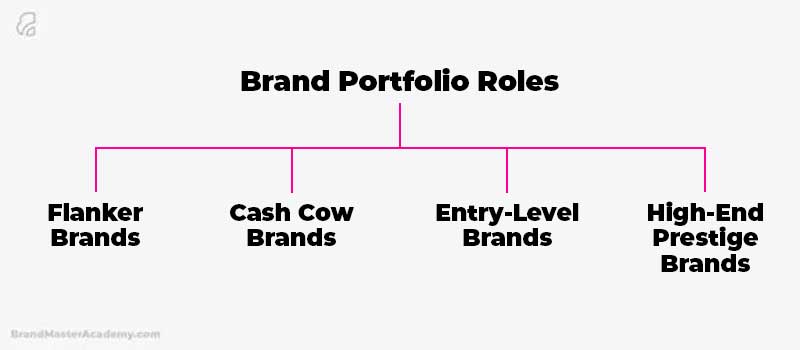
Let’s focus on four main brand portfolio roles: flanker brands, cash cow brands, low-end, entry-level brands, and high-end prestige brands.
Flanker Brands

A flanker brand is a company’s launching of a brand in a product category where it already has an established brand.
The new brand intends to meet the needs of potential customers that the original brand might not be able to satisfy within that product category.
The aim is to present distinctive brands to appeal to various consumers within different market segments without stepping on the toes of other brands within the portfolio.

For example, Diet Coke, is a flanker brand of Coke, allowing them to extend their reach into the more diet consciencious market.
Although the flagship and flanker brands are officially competitors (i.e. a customer may choose either Coke or Diet Coke), they actually work as a team to complement each other rather than eat into a shared audience.
By targeting different types of consumers within a product category, a parent company aims to strengthen a company’s market position and drive away rivals.
Cash Cow Brands
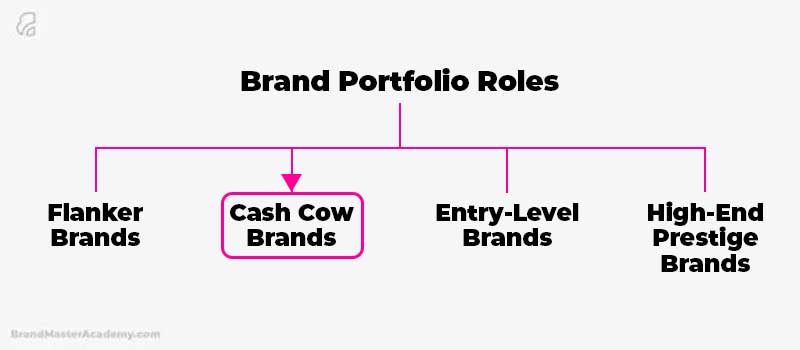
When a brand reaches a level of maturity and respect, is an established brand within the market, and brings in a sustainable profit, we call the brand a cash cow brand, more often than not the parent brand.
The branded product has matured in its life cycle and is still selling well enough to maintain cash flow.
As opposed to introducing any kind of new product to take their place, it’s better to do nothing and allow these brands to continue to generate revenue. Therefore, they’re rarely taken off the market.
Entry-Level Brands
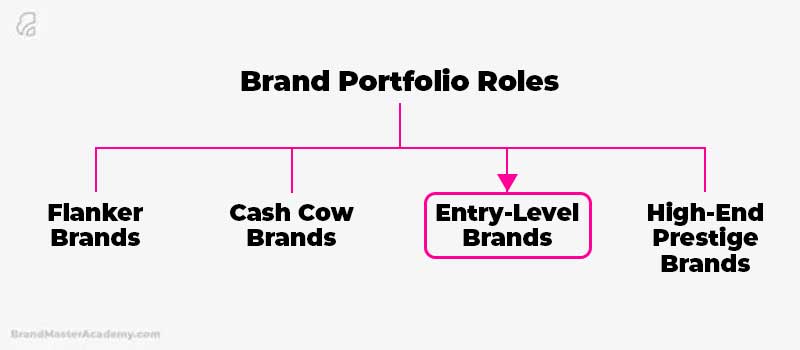
The low-end, entry-level brands are brands within the brand portfolio that offer low-priced products. These are the brands offering the cheapest products under the parent company’s brand umbrella.
Low prices can hook customers and attract them to the brand family.
The hope is that, once exposed to the lower price points of the entry-level brand, a customer may be tempted to try the other options provided by the parent brand.
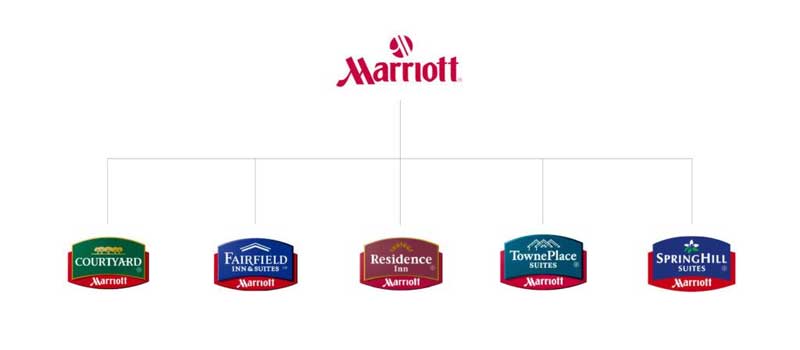
An example is when a consumer chooses to stay at the lowest-priced option with Marriott’s brand offerings.
If they appreciate the service and brand experience, the consumer may be more inclined to try one of Marriott’s more luxury brands in the future.
As a customer matures and their income increases over time, they’re more likely to increase their budget for hotel stays.
High-End Prestige Brands
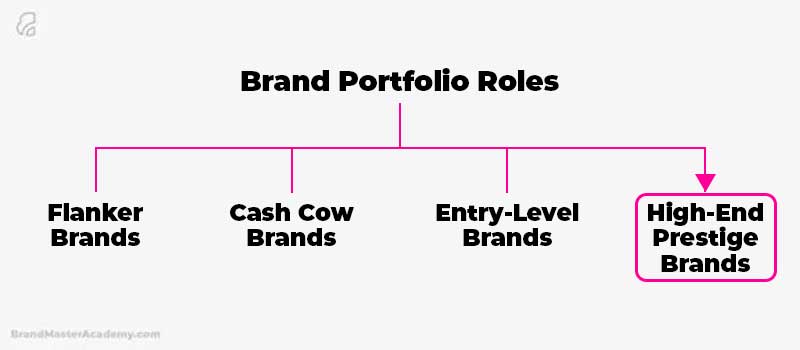
At the other end of the spectrum, high-end prestige brands intend to convey a sense of luxury and superior quality.
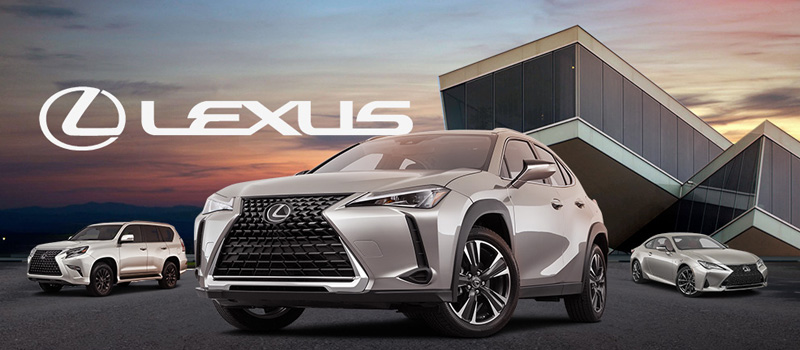
As mentioned in the above example, it would be very difficult for a brand such as Toyota, which has a reputation of affordability, to earn a slice of the luxury car market under the same brand.
Creating an independent luxury brand, disassociates from this reputation and allow the brand to establish it’s own reputation for presitige.
Advantages of Brand Portfolios

Effective brand management relies on understanding the audience. You must make a connection with the audience through brand messaging and experience and carefully manage that relationship.
However, customer preferences shift and, sometimes, a single brand can find that it faces a diminishing market share despite having a loyal customer base.
In this case, the brand strategists may believe that their existing brand can’t expand into new market segments without compromising their relationship with their customer base.
This is where the brand portfolio strategy can help to increase a company’s market share by acquiring existing brands or introducing new brands to a market.
With effective brand portfolio management, the brand portfolio becomes an entity to brand, as all brands under the umbrella follow the same core values and principles of the parent company.

Customers know to expect a high standard when buying Unilver products, for example, or to expect professionalism and innovation when dealing with Microsoft brands.
Some brands create clear alignments within portfolios from one brand to the next in “Branded House” structures, such as Virgin or FedEx, where brands are clearly within the same brand family.
On the other hand, “House of Brand” structures, such as Unilever and Proctor and Gamble, create more independence for brands within their portfilios with many customers unaware of the associations.
The brand architecture is a structural representation of the affiliations and partnerships between brands, and where associations are clear, brand equity and reputation and leveraged.

When Nestle or Kellogg’s introduces a new food product, the new product has perceived credibility with the Nestle or Kellogg’s logo on the box.
Virgin, is the parent brand at the head of a “brand family”.
The Virgin brand family leverages the “Branded House” structure, where each subbrand is an endorsed brand (i.e. endorsed by Virgin), with the Virgin logo part of the sub-brand identity.
As each new sub-brand is launched, it enters the market with the competitive advantage of the existing reputation of the parent brand, allowing Virgin to launch sub-brands such as Virgin Media, Virgin Mobile, and Virgin Atlantic to name just a few.
Generally speaking, If a customer trusts the products of one brand of the company and has a positive experience with the product, then there’s a higher chance that they will also trust the products of other brands of the company.
Brand Portfolio Examples

You can find brand portfolios across all industries, and you’ll find a variety of approaches.
Unilever (House Of Brands)

Unilever is the parent company of a vast brand family of over 400 companies worldwide offering products across the home goods, food, and healthcare industries.
They join the brands through a shared vision to ”do good” and make “Sustainable living commonplace.”
Nestle (Hybrid)
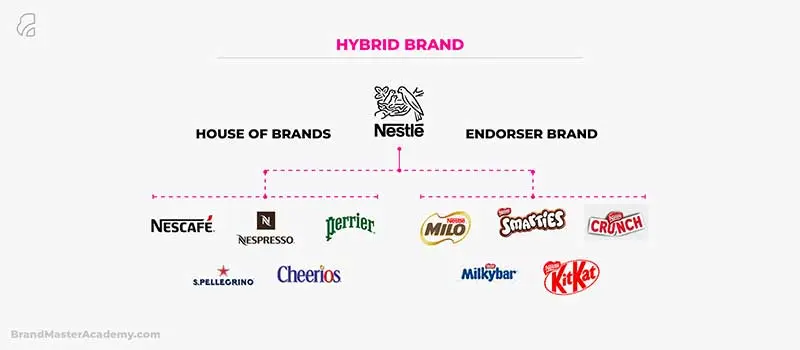
Nestle is the world’s largest food and beverage company, offering an eclectic mix of food products with something on almost every aisle of the supermarket.
Unlike other structures, Nestle’s brand architecture is a hybrid of both a Branded House and a House of Brands with endorsed brands with clear alignment and independent brands without.
Pepsico (House Of Brands)
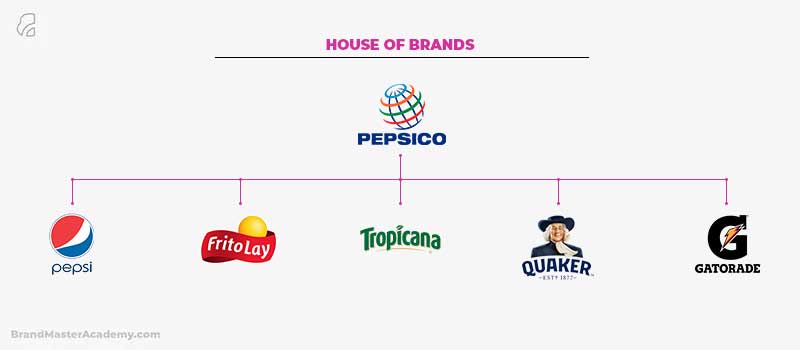
Pepsico is another brand behemoth, often thought of as the main competitor to the Coca-cola company due to the rivalry between the flagship brands.
After bringing Frito-Lay into its folds, its brand portfolio includes some of the giants of the beverage and potato chip industry.
Johnson and Johnson (House Of Brands)
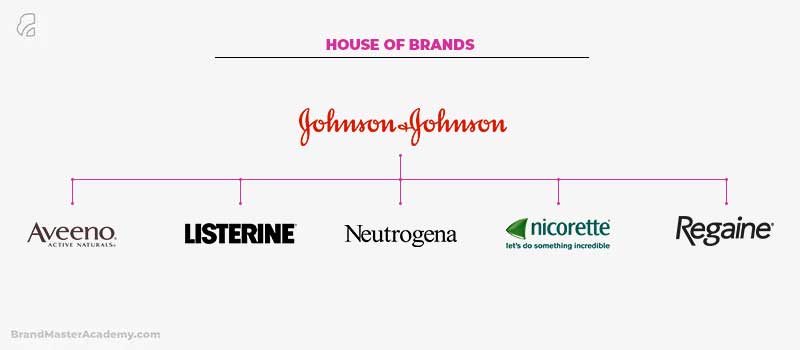
Johnson and Johnson’s brand portfolio spans several industries that fall under the broader healthcare sector.
Interestingly, all of J&J’s baby products, like soap, hair oil, and lotion, fall under a ‘Branded house’ architecture as they feature the Johnson & Johnson branding.
However, they did not decide to extend this branding to other products such as mouthwash, skincare, and pain relief. For example, J&J’s mouthwash products are branded under the Listerine label.
In fact, hundreds of brands operate semi-autonomously and semi-independently within J&J’s brand portfolio.
They are not closely tied or identified as J&J to the target audience but fall under their umbrella structure. This approach gives each brand an element of flexibility in its branding without having to stick to a rigid structure.
For example, J&J branded Nicorette doesn’t align thematically with baby lotion, so it makes sense to create a different brand,
Apple (Branded House)

Apple has created various sub-brands for its products, including the iPhone and Apple TV+.
Each product is known well enough to stand apart as product brands.
However, they all incorporate Apple branding and leverage the brand visual identity and ethos of the master brand.
In this way, Apple can insert new products into different markets with the weight of the overarching Apple brand and its credibility.
FedEx (Branded House)
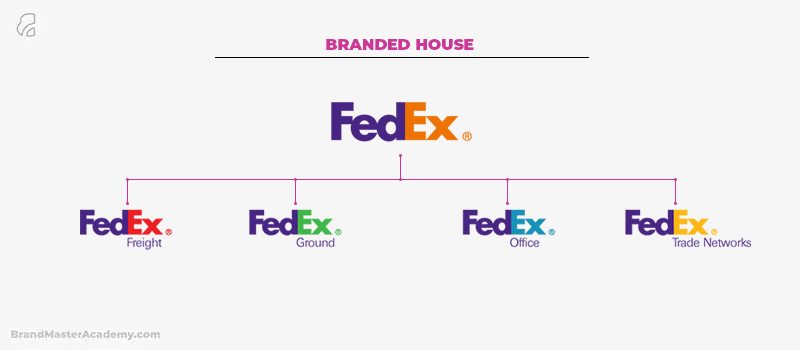
The FedEx brand portfolio features separate brands for each of its services.
Their brand lineup includes not FedEx Express, FedEx Freight, FedEx Ground and FedEx Kinkos.
The idea is that whatever your shipping need, package or freight, surface or air, U.S. or international, routine or emergency, next day or next week, FedEx has a designated branded service to match it.
Over To You
Correctly organizing the brand portfolio is essential since how a brand portfolio is managed directly affects the organization’s growth and future performance. The ideal portfolio should always align with how the company sees itself developing in the market.
When acquiring or creating new brands to add to a brand portfolio, it must fit into the broader brand strategy to help it achieve its goals.
Brands that do not suit the portfolio should either be changed to better conform with the parent brand’s strategy or be removed from the portfolio altogether.
On-Demand Digital Program
Brand Master Secrets
Make the transition from hired-gun to highly valued brand strategist in less than 30 days. The systems, frameworks and tools inside this comprehensive program are all you need to level up.








